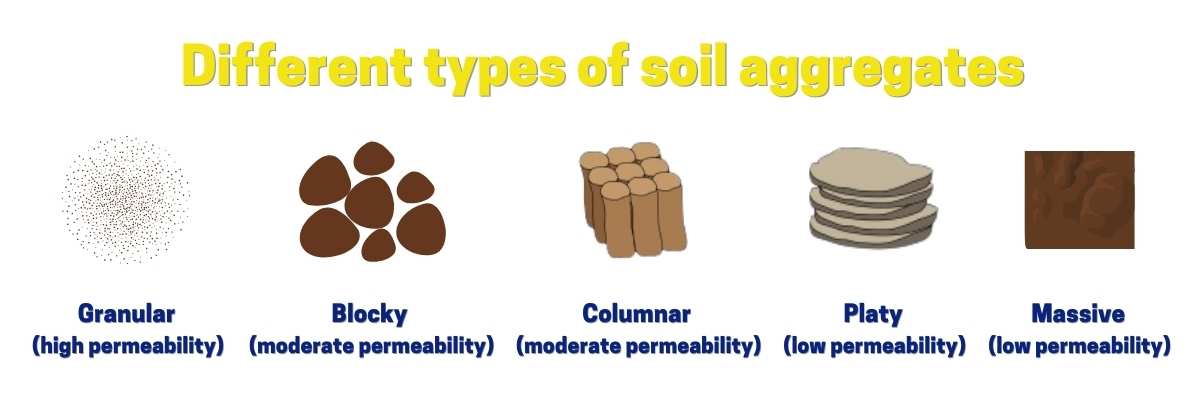QU'EST-CE QUE LE SOL?
Le sol maintient non seulement les plantes fermement ancrées, mais fournit également tous les nutriments essentiels aux plantes pour grandir et prospérer. La santé de la plante est directement liée à la qualité du sol. Par conséquent, il est crucial et important de choisir le bon type de sol pour les plantes que vous souhaitez faire pousser.
Nous avons dressé une liste de 5 choses auxquelles vous devez faire attention lorsque vous choisissez un substrat pour vos plantes.
1. Structure
La structure du sol est définie par la façon dont les particules individuelles de sable, de limon et d'argile sont assemblées. Ils sont cimentés ou liés ensemble par des processus physiques, chimiques et biologiques.
Certains d'entre eux incluent le processus biologique de cimentation des particules de sol par l'humus, par les colles organiques créées par les champignons et les bactéries décomposant la matière organique, et par les polymères et les sucres excrétés par les racines. Les racines et la matière organique sont donc des éléments essentiels de la structure d'un sol.
Les avantages d'une bonne structure du sol pour la croissance des plantes comprennent : une réduction de l'érosion en raison d'une plus grande résistance des agrégats du sol, une meilleure pénétration des racines et un meilleur accès à l'humidité du sol et aux nutriments, une meilleure émergence des semis en raison de la réduction de l'encroûtement de la surface et d'une plus grande infiltration d'eau, rétention et disponibilité.
La structure du sol est principalement classée par grade (degré d'agrégation), classe (taille moyenne) et type d'agrégats (forme). La forme, la taille et la résistance des agrégats déterminent la structure des pores et la facilité avec laquelle l'air, l'eau et les racines se déplacent dans le sol. Les différents types de granulats de sol sont :
- Granuleux : le plus courant à la surface du sol, offre le plus d'espace poreux de n'importe quelle structure.
- En bloc : un type de sol bien souvent avec un excès de sodium, qui détruit sa structure, permettant peu de mouvement d'air et d'eau.
- En colonne : un autre type de sol avec bien souvent un excès de sodium. L'eau circule plus difficilement et le drainage est mauvais.
- Plat : généralement un sol qui a été lessivé ou compacté par des animaux ou des machines. Tend à empêcher le mouvement descendant de l'eau et des racines des plantes à travers le sol.
- Massif : moins d'espace poreux, courant dans les sols compactés.

Un sol à structure granuleuse présente de nombreux avantages pour la croissance de vos plantes : il retient bien l'eau et les nutriments, offre un bon drainage et une bonne aération, permettant à votre système racinaire de bien se développer. La structure granulaire résiste également à l'érosion et au compactage et permet une bonne activité biologique dans votre sol.
TYPES DE SOLS
There are three main types of soil: sand, clay, and silt. These soils rarely have an ideal structure. They can be improved by adding nutrients or mixing soils. Sandy, clay and silty soils all benefit from frequently adding organic matter in the form of compost or composted manure.
- Peaty soil: this type of soil is acidic in nature and thus when it is combined with organic matter and compost; it offers countless benefits for the plants to grow.
- Clay soil: is naturally sticky and becomes hard when it dries. It allows little water to pass through, and must therefore be regularly mixed with organic matter or sand.
- Chalky soil: often shallow, stony and free-draining. Added organic matter can decompose rapidly, making them difficult to keep fertile. In order to improve and enhance the workability of this soil, hummus is often added.
For sandy soils this is best done in early spring, because working sandy soils in the fall promotes erosion. Adding basalt to sandy soils can also improve water retention and minerals. For clay and silty soils, the adding of organic matter is best done in late fall. Poorly drained clay soils can also be helped by adding sand. Clay soils can be very high in sodium, which prevents mineral particles from forming aggregates. Sodium clumps the soil together, preventing good water and air circulation. The structure of such high-sodium soils can be improved by working in gypsum (if the pH is neutral or alkaline) or lime (if the pH is acidic).
In addition to the main types of soil, there are also other various kinds of soil that you could select based on your plant’s requirements:
Humus
Microorganisms in soil break down organic matter, quickly releasing nutrients (mineralization) and forming humus, a process called humification. The organic matter decomposes to form earthy-smelling dark brown to black material and is called humus. Humus is mineralized in turn, but very slowly. This makes small amounts of nutrients available to plants over a very long time.
Recommendations for improving or maintaining soil structure:
- Regularly add organic matter like compost or composted manure.
- Encourage biological activity in the soil
- Correct the pH as necessary.
- Avoid overworking the soil. Hoe the soil or turn it over lightly.
- Use material like peat or mulch to help water retention.
- Avoid the use of sodium.
2. Water storage capacity
Plants need access to water in order to grow. The soil water storage (SWS) capacity is defined as the total amount of water that can be stored in the soil within the plant’s root zone. The storage capacity depends on both the soil texture and organic matter.
In terms of soil texture, structures that are made up of smaller particle sizes, like silt and clay, have a larger surface area. The larger the surface area, the easier it is for the soil to hold onto water so it has a higher water holding capacity. Sand in comparison has large particle sizes which results in a smaller surface area. The water holding capacity for sand is therefore low.
Organic matter in soil is another factor that can help increase water holding capacity. Organic matter is decayed material that originated from a living organism and has a natural magnetism to water. It increases soil fertility by providing a reserve of plant nutrients like nitrogen (N) and phosphorus (P). As such, the amount of organic matter and soil fertility are significantly correlated.
3. Nutrients
Soil is a major source of nutrients that are needed for your plants to grow. The three main nutrients are nitrogen (N), phosphorus (P) and potassium (K). Together they make up the trio known as NPK. Other important nutrients for plants are calcium, magnesium and sulphur. Plants also need small quantities of iron, manganese, zinc, copper, boron and molybdenum, known as trace elements because only traces are needed by the plant.
NPK
Nitrogen is a key element in plant growth. It is found in all plant cells, in plant proteins, enzymes and in chlorophyll. Phosphorus helps transfer energy from sunlight to plants, stimulates early root and plant growth, and hastens maturity. Potassium increases vigour and disease resistance of plants, helps form and move starches, sugars and oils in plants, and can improve fruit quality.
Calcium
Calcium is essential for the plant’s root health, growth of new roots and root hairs. Calcium also contributes to the development of leaves.
Magnesium
Magnesium is a key component of chlorophyll, the material which gives plants a green colour, and is vital for photosynthesis. Magnesium deficiencies occur mainly on sandy acid soils in high rainfall areas. Too much potassium can also produce a magnesium deficiency. This is something to look out for when you grow plants that use a lot of potassium, like bananas.
Sulphur
Sulphur is a component of amino acids in plant proteins and is involved in energy-producing processes in plants. It is also responsible for many flavour and odour compounds in plants such as the aroma of onions and cabbage. Sulphur deficiency should not be a problem in soils which are high in organic matter, but it leaches easily.
4. pH value
Soils can be naturally acid or alkaline, and this can be measured by testing their pH value. Having the correct pH is important for healthy plant growth.
The more fertiliser a plant takes up, the more acid it releases, dropping the pH value in the medium. If the medium is acidic from the beginning, or if we use an abundance of pH decreasing products (if we use too much fertiliser or pH correctors like pH minus or plus), the pH level can drop to the level of the acid inside the root, making the plant unable to get rid of the acid surplus and stop taking up fertiliser.
A plant that’s in a pot for months, can suddenly become weak and root badly. Then, there is most likely an excess of acid in the soil and the plant can’t grow wholesomely. This is because the nutrients, even if present in abundance, can not be taken up. Instead of adding fertiliser, you can rinse or replace the soil and give only root supplements that are poor in salt content, until the plants start growing considerably again.
Acidic soil
A development of strongly acidic soils (less than 5.5 pH) can result in poor plant growth as a result of one or more of the following factors:
- aluminium toxicity
- manganese toxicity
- calcium deficiency
- magnesium deficiency
- low levels of essential plant nutrients such as phosphorus and molybdenum
Alkaline soil
Alkaline soils, on the other hand, may have problems with deficiencies of nutrients such as zinc, copper, boron and manganese. Soils with an extremely alkaline pH (greater than 9) are also likely to have high levels of sodium.
A slightly acidic pH value in the medium between 5.8 and 6.2 is ideal to ensure an uninhibited uptake of fertiliser.
5. Electrical conductance value (EC value)
Soil electrical conductivity (EC) is a measure of the amount of salts in soil, also called salinity of soil. High concentration of salt in the plant medium therefore equals a high EC value. Too much salt causes stress due to energy-consuming salt selection, and a low conductance value causes stress due to a lack of nutrients. Young plants with few roots prefer less salts than older plants, especially near the end of blooming. There is no clear conductance value which is advised for plants, since plants can get used to a high or low level. However, a conductance value between 0.5 and 1.8 mS/cm are acceptable. This level can ofcourse be higher during blooming.
- CONSEILS DE CULTURE: INSPIRATION , PRODUITS HESI , INFORMATIONS SUR LA CULTURE
 Deutsch
Deutsch  English
English  Español
Español 
.png?ts=1660491869)